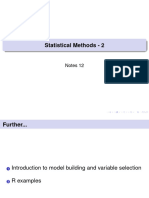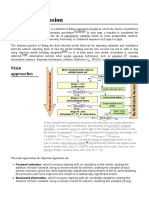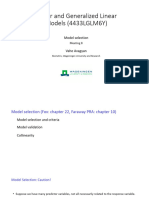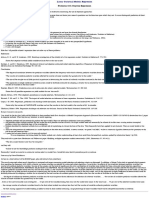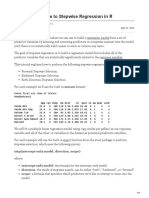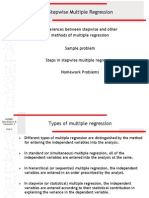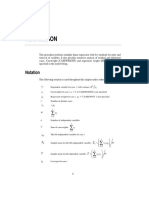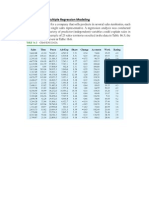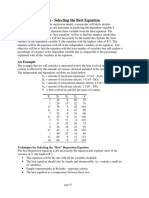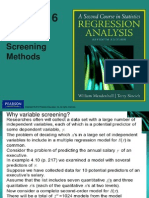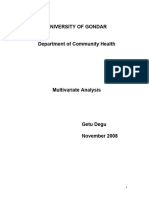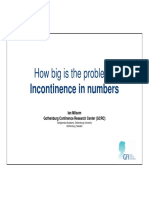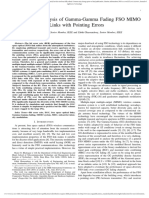NCSS Statistical Software NCSS.
com
Chapter 311
Stepwise Regression
Introduction
Often, theory and experience give only general direction as to which of a pool of candidate variables
(including transformed variables) should be included in the regression model. The actual set of predictor
variables used in the final regression model must be determined by analysis of the data. Determining this
subset is called the variable selection problem.
Finding this subset of regressor (independent) variables involves two opposing objectives. First, we want the
regression model to be as complete and realistic as possible. We want every regressor that is even remotely
related to the dependent variable to be included. Second, we want to include as few variables as possible
because each irrelevant regressor decreases the precision of the estimated coefficients and predicted
values. Also, the presence of extra variables increases the complexity of data collection and model
maintenance. The goal of variable selection becomes one of parsimony: achieve a balance between
simplicity (as few regressors as possible) and fit (as many regressors as needed).
There are many different strategies for selecting variables for a regression model. If there are no more than
fifteen candidate variables, the All Possible Regressions procedure (discussed in the next chapter) should be used
since it will always give as good or better models than the stepping procedures available in this procedure. On
the other hand, when there are more than fifteen candidate variables, the four search procedures contained in
this procedure may be of use.
These search procedures will often find very different models. Outliers and collinearity can cause this. If there is
very little correlation among the candidate variables and no outlier problems, the four procedures should find
the same model.
We will now briefly discuss each of these procedures.
Variable Selection Procedures
Forward (Step-Up) Selection
This method is often used to provide an initial screening of the candidate variables when a large group of
variables exists. For example, suppose you have fifty to one hundred variables to choose from, way outside the
realm of the all-possible regressions procedure. A reasonable approach would be to use this forward selection
procedure to obtain the best ten to fifteen variables and then apply the all-possible algorithm to the variables in
this subset. This procedure is also a good choice when multicollinearity is a problem.
The forward selection method is simple to define. You begin with no candidate variables in the model. Select
the variable that has the highest R-Squared. At each step, select the candidate variable that increases R-Squared
the most. Stop adding variables when none of the remaining variables are significant. Note that once a variable
enters the model, it cannot be deleted.
311-1
© NCSS, LLC. All Rights Reserved.
�NCSS Statistical Software NCSS.com
Stepwise Regression
Backward (Step-Down) Selection
This method is less popular because it begins with a model in which all candidate variables have been included.
However, because it works its way down instead of up, you are always retaining a large value of R-Squared. The
problem is that the models selected by this procedure may include variables that are not really necessary. The
user sets the significance level at which variables can enter the model.
The backward selection model starts with all candidate variables in the model. At each step, the variable that is
the least significant is removed. This process continues until no nonsignificant variables remain. The user sets
the significance level at which variables can be removed from the model.
Stepwise Selection
Stepwise regression is a combination of the forward and backward selection techniques. It was very popular at
one time, but the Multivariate Variable Selection procedure described in a later chapter will always do at least as
well and usually better.
Stepwise regression is a modification of the forward selection so that after each step in which a variable was
added, all candidate variables in the model are checked to see if their significance has been reduced below the
specified tolerance level. If a nonsignificant variable is found, it is removed from the model.
Stepwise regression requires two significance levels: one for adding variables and one for removing variables.
The cutoff probability for adding variables should be less than the cutoff probability for removing variables so
that the procedure does not get into an infinite loop.
Min MSE
This procedure is similar to the Stepwise Selection search procedure. However, instead of using probabilities to
add and remove, you specify a minimum change in the root mean square error. At each step, the variable
whose status change (in or out of the model) will decrease the mean square error the most is selected and its
status is reversed. If it is currently in the model, it is removed. If it is not in the model, it is added. This process
continues until no variable can be found that will cause a change larger than the user-specified minimum
change amount.
Assumptions and Limitations
The same assumptions and qualifications apply here as applied to multiple regression. Note that outliers
can have a large impact on these stepping procedures, so you must make some attempt to remove outliers
from consideration before applying these methods to your data.
The greatest limitation with these procedures is one of sample size. A good rule of thumb is that you have at
least five observations for each variable in the candidate pool. If you have 50 variables, you should have 250
observations. With less data per variable, these search procedures may fit the randomness that is inherent
in most datasets and spurious models will be obtained.
This point is critical. To see what can happen when sample sizes are too small, generate a set of random
numbers for 20 variables with 30 observations. Run any of these procedures and see what a magnificent
value of R-Squared is obtained, even though its theoretical value is zero!
311-2
© NCSS, LLC. All Rights Reserved.
�NCSS Statistical Software NCSS.com
Stepwise Regression
Using This Procedure
This procedure performs one portion of a regression analysis: it obtains a set of independent variables from
a pool of candidate variables. Once the subset of variables is obtained, you should proceed to the Multiple
Regression procedure to estimate the regression coefficients, study the residuals, and so on.
Data Structure
An example of data appropriate for this procedure is shown in the table below. This data is from a study of
the relationships of several variables with a person’s IQ. Fifteen people were studied. Each person’s IQ was
recorded along with scores on five different personality tests. The data are contained in the IQ dataset. We
suggest that you open this database now so that you can follow along with the example.
IQ Dataset
Test1 Test2 Test3 Test4 Test5 IQ
83 34 65 63 64 106
73 19 73 48 82 92
54 81 82 65 73 102
96 72 91 88 94 121
84 53 72 68 82 102
86 72 63 79 57 105
76 62 64 69 64 97
54 49 43 52 84 92
37 43 92 39 72 94
42 54 96 48 83 112
71 63 52 69 42 130
63 74 74 71 91 115
69 81 82 75 54 98
81 89 64 85 62 96
50 75 72 64 45 103
Missing Values
Rows with missing values in the active variables are ignored.
311-3
© NCSS, LLC. All Rights Reserved.
�NCSS Statistical Software NCSS.com
Stepwise Regression
Example 1 – Stepwise Regression Analysis
This section presents an example of how to run a stepwise regression analysis of the data presented in the
IQ dataset.
Setup
To run this example, complete the following steps:
1 Open the IQ example dataset
• From the File menu of the NCSS Data window, select Open Example Data.
• Select IQ and click OK.
2 Specify the Stepwise Regression procedure options
• Find and open the Stepwise Regression procedure using the menus or the Procedure Navigator.
• The settings for this example are listed below and are stored in the Example 1 settings file. To load
these settings to the procedure window, click Open Example Settings File in the Help Center or File
menu.
Variables Tab
___________________________________________________________________________________________________________________________________________________________________________________________________________________________________________________________________________________________________________________________________________________________________________________________________________________________________________________________________________________________________________________________________________________________________________________________________________________________________________________________________________________________________________
Y: Dependent Variable..................................... IQ
X's: Independent Variables .............................. Test1-Test5
Selection Method ............................................. Backward
Reports Tab
___________________________________________________________________________________________________________________________________________________________________________________________________________________________________________________________________________________________________________________________________________________________________________________________________________________________________________________________________________________________________________________________________________________________________________________________________________________________________________________________________________________________________________
Report Format.................................................. Verbose
Descriptive Statistics........................................ Checked
3 Run the procedure
• Click the Run button to perform the calculations and generate the output.
311-4
© NCSS, LLC. All Rights Reserved.
�NCSS Statistical Software NCSS.com
Stepwise Regression
Descriptive Statistics
Descriptive Statistics
────────────────────────────────────────────────────────────────────────
Standard
Variable Count Mean Deviation
──────────────────────────────────────────────────────────
Test1 15 67.93333 17.39239
Test2 15 61.4 19.39735
Test3 15 72.33334 14.73415
Test4 15 65.53333 13.95332
Test5 15 69.93333 16.15314
IQ 15 104.3333 11.0173
────────────────────────────────────────────────────────────────────────
For each variable, the Count, Mean, and Standard Deviation are calculated. This report is especially useful
for making certain that you have selected the right variables and that the appropriate number of rows was
used.
Iteration Details (Verbose Version)
Iteration Details
────────────────────────────────────────────────────────────────────────
Iteration 0: Unchanged
──────────────────────────────────────────────────────────────────────────────────────────────────────────────────────────────
R-Squared Percent
Standardized ─────────────────── Change in
In Variable Coefficient Increment vs. Other X's T-Value P-Value Sqrt(MSE)
──────────────────────────────────────────────────────────────────────────────────────────────────────────────────────────────
Yes Test1 -3.0524 0.235717 0.974701 -1.8789 0.092969 11.9387
Yes Test2 -2.9224 0.241441 0.971730 -1.9016 0.089661 12.3210
Yes Test3 0.1404 0.015210 0.227987 0.4773 0.644541 -3.9386
Yes Test4 4.7853 0.283243 0.987631 2.0596 0.069522 15.0741
Yes Test5 -0.0595 0.002715 0.232860 -0.2017 0.844669 -4.9176
──────────────────────────────────────────────────────────────────────────────────────────────────────────────────────────────
R-Squared = 0.399068 Sqrt(MSE) = 10.65198
Iteration 1: Removed Test5 from the Model
──────────────────────────────────────────────────────────────────────────────────────────────────────────────────────────────
R-Squared Percent
Standardized ─────────────────── Change in
In Variable Coefficient Increment vs. Other X's T-Value P-Value Sqrt(MSE)
──────────────────────────────────────────────────────────────────────────────────────────────────────────────────────────────
Yes Test1 -3.0612 0.237250 0.974683 -1.9825 0.075558 12.5340
Yes Test2 -2.9032 0.239195 0.971621 -1.9906 0.074546 12.6640
Yes Test3 0.1163 0.012499 0.075203 0.4550 0.658798 -3.6717
Yes Test4 4.7850 0.283206 0.987631 2.1660 0.055543 15.5681
No Test5 0.002715 0.232860 0.2017 0.844669 5.1719
──────────────────────────────────────────────────────────────────────────────────────────────────────────────────────────────
R-Squared = 0.396353 Sqrt(MSE) = 10.12816
311-5
© NCSS, LLC. All Rights Reserved.
�NCSS Statistical Software NCSS.com
Stepwise Regression
Iteration 2: Removed Test3 from the Model
──────────────────────────────────────────────────────────────────────────────────────────────────────────────────────────────
R-Squared Percent
Standardized ─────────────────── Change in
In Variable Coefficient Increment vs. Other X's T-Value P-Value Sqrt(MSE)
──────────────────────────────────────────────────────────────────────────────────────────────────────────────────────────────
Yes Test1 -3.1020 0.244443 0.974597 -2.0890 0.060743 13.1519
Yes Test2 -2.9024 0.239064 0.971621 -2.0659 0.063218 12.7977
Yes Test4 4.7988 0.284897 0.987628 2.2553 0.045468 15.7808
No Test3 0.012499 0.075203 0.4550 0.658798 3.8116
No Test5 0.000005 0.081040 0.0087 0.993205 4.8805
──────────────────────────────────────────────────────────────────────────────────────────────────────────────────────────────
R-Squared = 0.383854 Sqrt(MSE) = 9.756291
Iteration 3: Unchanged
──────────────────────────────────────────────────────────────────────────────────────────────────────────────────────────────
R-Squared Percent
Standardized ─────────────────── Change in
In Variable Coefficient Increment vs. Other X's T-Value P-Value Sqrt(MSE)
──────────────────────────────────────────────────────────────────────────────────────────────────────────────────────────────
Yes Test1 -3.1020 0.244443 0.974597 -2.0890 0.060743 13.1519
Yes Test2 -2.9024 0.239064 0.971621 -2.0659 0.063218 12.7977
Yes Test4 4.7988 0.284897 0.987628 2.2553 0.045468 15.7808
No Test3 0.012499 0.075203 0.4550 0.658798 3.8116
No Test5 0.000005 0.081040 0.0087 0.993205 4.8805
──────────────────────────────────────────────────────────────────────────────────────────────────────────────────────────────
R-Squared = 0.383854 Sqrt(MSE) = 9.756291
────────────────────────────────────────────────────────────────────────
This report presents information about each step of the search procedures. You can scan this report to see
if you would have made the same choice. Each report shows the statistics after the specified action (entry or
removal) was taken.
For each iteration, there are three possible actions:
1. Unchanged. No action was taken because of the scan in this step. Because of the “backward look” in
the stepwise search method, this will show up a lot when this method is used. Otherwise, it will
usually show up as the first and last steps.
2. Removal. A variable was removed from the model.
3. Entry. A variable was added to the model.
Individual definitions of the items on the report are as follows:
In
A Yes means the variable is in the model. A No means it is not.
Variable
This is the name of the candidate variable.
Standardized Coefficient
Standardized regression coefficients are the coefficients that would be obtained if you standardized each
independent and dependent variable. Here standardizing is defined as subtracting the mean and dividing by
the standard deviation of a variable. A regression analysis on these standardized variables would yield these
standardized coefficients.
311-6
© NCSS, LLC. All Rights Reserved.
�NCSS Statistical Software NCSS.com
Stepwise Regression
When there are vastly different units involved for the variables, this is a way of making comparisons
between variables. The formula for the standardized regression coefficient is:
𝑠𝑠𝑥𝑥𝑗𝑗
𝑏𝑏𝑗𝑗,𝑠𝑠𝑠𝑠𝑠𝑠 = 𝑏𝑏𝑗𝑗 � �
𝑠𝑠𝑦𝑦
where 𝑠𝑠𝑦𝑦 and 𝑠𝑠𝑥𝑥𝑗𝑗 are the standard deviations for the dependent variable and the corresponding jth
independent variable.
R-Squared - Increment
This is the amount that R-Squared would be changed if the status of this variable were changed. If the
variable is currently in the model, this is the amount the R-Squared value would be decreased if it were
removed. If the variable is currently out of the model, this is the amount the overall R-Squared would be
increased if it were added. Large values here indicate important independent variables.
You want to add variables that make a large contribution to R-Squared and to delete variables that make a
small contribution to R-Squared.
R-Squared – vs. Other X’s
This is a collinearity measure, which should be as small as possible. This is the R-Squared value that would
result if this independent variable were regressed on all the other independent variables currently in the model.
T-Value
This is the t-value for testing the hypothesis that this variable should be added to, or deleted from, the model.
The test is adjusted for the rest of the variables in the model. The larger this t-value is, the more important the
variable.
P-Value
This is the two-tail p-value for the above t-value. The smaller this p-value, the more important the independent
variable is. This is the significance value that is compared to the values of PIN and POUT (see Stepwise Method
above).
Percent Change in Sqrt(MSE)
This is the percentage change in the square root of the mean square error that would occur if the specified
variable were added to, or deleted from, the model. This is the value that is used by the Min MSE search
procedure. This percentage change in root mean square error (RMSE) is computed as follows:
𝑅𝑅𝑅𝑅𝑅𝑅𝑅𝑅𝑝𝑝𝑝𝑝𝑝𝑝𝑝𝑝𝑝𝑝𝑝𝑝𝑝𝑝𝑝𝑝 − 𝑅𝑅𝑅𝑅𝑅𝑅𝑅𝑅𝑐𝑐𝑐𝑐𝑐𝑐𝑐𝑐𝑐𝑐𝑐𝑐𝑐𝑐
𝑃𝑃𝑃𝑃𝑃𝑃𝑃𝑃𝑃𝑃𝑃𝑃𝑃𝑃 𝑐𝑐ℎ𝑎𝑎𝑎𝑎𝑎𝑎𝑎𝑎 = � � 100
𝑅𝑅𝑅𝑅𝑅𝑅𝑅𝑅𝑐𝑐𝑐𝑐𝑐𝑐𝑐𝑐𝑐𝑐𝑐𝑐𝑐𝑐
R-Squared
This is the R-Squared value for the current model.
Sqrt(MSE)
This is the square root of the mean square error for the current model.
311-7
© NCSS, LLC. All Rights Reserved.
�NCSS Statistical Software NCSS.com
Stepwise Regression
Iteration Details (Brief Version)
This report was not printed because the Report Format box on the Reports tab was set to Verbose. If Report
Format is set to Brief, the following output is displayed:
Iteration Details
────────────────────────────────────────────────────────────────────────
Maximum
Iteration R-Squared
Number Action Variable R-Squared Sqrt(MSE) vs. Other X's
──────────────────────────────────────────────────────────────────────────────────────────────────────
0 Unchanged 0.399068 10.65198 0.987631
1 Removed Test5 0.396353 10.12816 0.987631
2 Removed Test3 0.383854 9.756291 0.987628
3 Unchanged 0.383854 9.756291 0.987628
────────────────────────────────────────────────────────────────────────
This is an abbreviated report summarizing the statistics at each iteration. Individual definitions of the items
on the report are as follows:
Iteration Number
The number of this iteration.
Action
For each iteration, there are three possible actions:
1. Unchanged. No action was taken because of the scan in this step. Because of the “backward look” in
the stepwise search method, this will show up a lot when this method is used. Otherwise, it will
show up at the first and last steps.
2. Removed. A variable was removed from the model.
3. Added. A variable was added to the model.
Variable
This is the name of the variable whose status is being changed.
R-Squared
The value of R-Squared for the current model.
Sqrt(MSE)
This is the square root of the mean square error for the current model.
Maximum R-Squared vs. Other X’s
This is the maximum value of R-Squared – vs. Other X’s (see verbose report definitions) for all the variables
in the model. This is a collinearity model. You want this value to be as small as possible. If it approaches
0.99, you should be concerned with the possibility that multicollinearity is distorting your results.
311-8
© NCSS, LLC. All Rights Reserved.
�NCSS Statistical Software NCSS.com
Stepwise Regression
List of Variables Selected
List of Variables Selected
─────────────────────────────────────────────────────────────────────────
Test1, Test2, Test4
─────────────────────────────────────────────────────────────────────────
This report lists the variables selected by the stepwise regression procedure.
311-9
© NCSS, LLC. All Rights Reserved.


